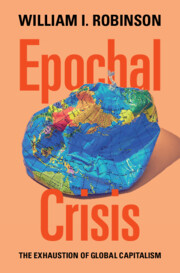Refine search
Actions for selected content:
57 results
Chapter 1 - Data-Intensive Approaches to English Linguistics
-
-
- Book:
- Data-Intensive Investigations of English
- Published online:
- 03 December 2025
- Print publication:
- 18 December 2025, pp 1-19
-
- Chapter
- Export citation
A socio-technical perspective on digital twins as GovTech solutions: the case of WiseTown
- Part of
-
- Journal:
- Data & Policy / Volume 7 / 2025
- Published online by Cambridge University Press:
- 01 December 2025, e82
-
- Article
-
- You have access
- Open access
- HTML
- Export citation
Decoding the digital thread digitalization approach for product design and development: benefits, challenges, and extensions
-
- Article
-
- You have access
- Open access
- HTML
- Export citation

Epochal Crisis
- The Exhaustion of Global Capitalism
-
- Published online:
- 21 August 2025
- Print publication:
- 04 September 2025
EU Environmental Law in the Digital Age: A Critical Outlook on the Twin Transition’s Legal Structure
-
- Journal:
- European Journal of Risk Regulation , First View
- Published online by Cambridge University Press:
- 28 July 2025, pp. 1-17
-
- Article
-
- You have access
- Open access
- HTML
- Export citation
Introduction
-
- Book:
- The International Tax Revolution
- Published online:
- 28 June 2025
- Print publication:
- 03 July 2025, pp 1-10
-
- Chapter
- Export citation
13 - The Return of Instability
-
- Book:
- Money In Crisis
- Published online:
- 15 July 2025
- Print publication:
- 12 June 2025, pp 335-352
-
- Chapter
- Export citation
Impact of insurers’ technology accessibility as private information on market structure
-
- Journal:
- ASTIN Bulletin: The Journal of the IAA / Volume 55 / Issue 3 / September 2025
- Published online by Cambridge University Press:
- 13 May 2025, pp. 564-584
- Print publication:
- September 2025
-
- Article
- Export citation
Asking for More Than Answers: Online Shareholder Activism and Corporate Green Innovation
-
- Journal:
- Management and Organization Review / Volume 20 / Issue 6 / December 2024
- Published online by Cambridge University Press:
- 20 March 2025, pp. 988-1024
-
- Article
- Export citation
28 - Financial Innovation in the Process of Financial Inclusion
- from Part V - Financial Innovation and Sustainability
-
-
- Book:
- The Cambridge Handbook of EU Sustainable Finance
- Published online:
- 30 January 2025
- Print publication:
- 06 February 2025, pp 712-742
-
- Chapter
- Export citation
‘Digital Divide’: How Do Central and Local SOEs Respond Differently to Digitalization in China
-
- Journal:
- Management and Organization Review / Volume 20 / Issue 5 / October 2024
- Published online by Cambridge University Press:
- 07 January 2025, pp. 748-772
-
- Article
-
- You have access
- Open access
- HTML
- Export citation
Promoting Digitalization of Electronic Trade Documents in Nigeria through the Model Law on Electronic Transferable Records
-
- Journal:
- Journal of African Law / Volume 69 / Issue 1 / February 2025
- Published online by Cambridge University Press:
- 16 December 2024, pp. 53-72
- Print publication:
- February 2025
-
- Article
- Export citation
Female music entrepreneurs’ use of international social capital and digital technology
-
- Journal:
- Journal of Management & Organization / Volume 30 / Issue 6 / November 2024
- Published online by Cambridge University Press:
- 04 December 2024, pp. 2336-2349
-
- Article
-
- You have access
- Open access
- HTML
- Export citation
Part I - Introduction
-
- Book:
- Digital Innovation Strategy
- Published online:
- 21 December 2023
- Print publication:
- 21 December 2023, pp 1-54
-
- Chapter
- Export citation
Investigating digital technologies’ implementation in circular businesses: Evidence from the going circular path
-
- Journal:
- Journal of Management & Organization / Volume 30 / Issue 3 / May 2024
- Published online by Cambridge University Press:
- 29 November 2023, pp. 421-451
-
- Article
-
- You have access
- Open access
- HTML
- Export citation
Towards a Public Law Perspective on the Constitutional Law of Privacy in South Africa in the Age of Digitalization
-
- Journal:
- Journal of African Law / Volume 68 / Issue 1 / February 2024
- Published online by Cambridge University Press:
- 06 November 2023, pp. 89-107
- Print publication:
- February 2024
-
- Article
-
- You have access
- Open access
- HTML
- Export citation
Documenting Crisis: Artistic Innovation and Institutional Transformations in the German-Speaking Countries and the UK
-
- Journal:
- New Theatre Quarterly / Volume 39 / Issue 4 / November 2023
- Published online by Cambridge University Press:
- 08 November 2023, pp. 333-354
- Print publication:
- November 2023
-
- Article
-
- You have access
- Open access
- Export citation
Globotics and Development: When Manufacturing Is Jobless and Services Are Tradeable
-
- Journal:
- World Trade Review / Volume 22 / Issue 3-4 / October 2023
- Published online by Cambridge University Press:
- 05 September 2023, pp. 302-311
- Print publication:
- October 2023
-
- Article
-
- You have access
- Open access
- HTML
- Export citation
2 - What Is the Fourth Industrial Revolution?
-
- Book:
- Africa's Fourth Industrial Revolution
- Published online:
- 08 June 2023
- Print publication:
- 22 June 2023, pp 8-23
-
- Chapter
- Export citation
Chapter 10 - Case Study Research Revisited
- from Part II - Methodological Considerations
-
-
- Book:
- Cambridge Handbook of Qualitative Digital Research
- Published online:
- 08 June 2023
- Print publication:
- 22 June 2023, pp 140-159
-
- Chapter
- Export citation
